|
|
home
This column is prepared in cooperation
with the Museology-Educational Experimental Centre of the Andy Warhol
Association in Medzilaborce.
http://www.andywarhol.sk,
bycko@centrum.sk
John
Warhola is dead
Andy
Warhol + Dano Brogyányi
The writer Michal Šmajda enters the encyclopaedia of
personalities “WHO’S
WHO”
Six of Warhol’s paintings sold for 31.199.000 USD
in an auction
Andy Warhol in
Slovakia
More Than 15 Minutes
A man from nowhere
GREEN CAR CRASH
In the
last year, the value of Andy Warhol´s works has increased by 50 - 200%
I.
Gašparovič is the first president to visit an exhibition opening of A.
Warhol’s works
ANDY
WARHOL - LIFE AND ART WORK
Andy
Warhol - DEATH AND LIFE
Andy Warhol
“15 YEARS OF FAME“
Warholovce
Warhol is better known in Serbia than in our country
|
John Warhola is
dead
Obituary: John Warhola / Brother who was told, 'Your role is to
take care of Andy'
May 31, 1925 – Dec. 24, 2010
Saturday, December 25, 2010
Before he died from drinking bad water at one of the
construction sites where he worked, Andrij Warhola called his
son John into the room for a talk about the family's future.
At 17, with his kid brother and mom to care for and another away
in the military – World War II was raging -- John Warhola
received a special order. His dad had stored away enough savings
bonds to put the youngest boy through the first two years of
college. The rest was up to John.
"My grandfather told my father, 'Your role is to take care of
Andy and make sure he goes to school, because he's going to be
successful someday,'" said Mr. Warhola's son, Donald.
In the years after, John Warhola sold parts for washers, dryers
and stoves at a Sears store. When television arrived, he climbed
roofs and installed the antennas. He cared for his mom and
younger brother and sent Andy to Carnegie Tech and then on to
New York City where he shortened the family name and became Andy
Warhol.
Art legends must be born, but sometimes it takes an older
brother to keep them from starving.
On one occasion, John Warhola took the Greyhound bus to visit
his brother as he started out. He noticed cardboard plugging the
holes in Andy's shoes. He left his own behind for his kid
brother. Another time, after their mom, Julia, moved in with
Andy in Manhattan, John visited to make sure they had turkey on
Thanksgiving.
John Warhola, of Freedom, Beaver County, died at Allegheny
General Hospital of pneumonia on Christmas Eve. He was 85.
Andy Warhol was often depicted as aloof, inscrutable -- a man
running as fast as he could from his blue-collar, Pittsburgh
roots. That was a myth, said Donald Warhola, and he knew because
he was at home every Sunday when John and Andy talked.
The icon of pop art wanted weekly details about family and all
things Pittsburgh.
"There's only one Andy Warhol. I know my father would not want
that credit of being responsible or creating, but he played a
pivotal role in helping Andy become what he wanted to become. He
did that out of the love of his heart," said Donald Warhola.
Andy Warhol died in 1987 and his own dying instructions
specified that his brother John would sit on the board of the
foundation that oversees the Warhol legacy. Mr. Warhola was one
of three board members who oversaw the Andy Warhol Foundation,
and he became a key player in setting up the museum that bears
the artist's name as well as another Andy Warhol museum in the
family's ancestral home in Medzilaborce, Slovakia.
"We are losing our own father, our founder," said Michal Bycko,
curator of the museum in Slovakia. "With the sudden departure of
John Warhola, our museum is losing its soul."
Another board member, Rick Lowe, an artist in Houston, Texas,
said John Warhola's family connection was essential in
understanding Andy Warhol outside the context of the art world.
On visits by board members, Mr. Warhola would sometimes take
them on a tour of the Oakland neighborhood in which the artist
was raised.
"He was very interested in showing the board members the family
home. He was interested in finding a way to preserve that," Mr.
Lowe said.
In addition to his role with the art foundation, Mr. Warhola
became the caregiver to his wife, Margaret, who was disabled by
a stroke in 1995. Mrs. Warhola died in 2007.
While another brother, Paul Warhola, became an artist late in
life with public exhibitions and widespread interest, Donald
Warhola said his dad preferred to focus on the museums and his
three children.
"His family was basically his hobby," he said.
In addition to his son Donald, of Cranberry, and brother Paul,
of West Homestead, Mr. Warhola is survived by sons Mark, of
Cranberry, and Jeffrey, of New Wilmington, Lawrence County.
Friends will be received from 2 to 4 and 7 to 9 p.m. Monday and
Tuesday at the Thomas P. Kunsak Funeral Home, North Side, with a
funeral to be held at 10 a.m. Wednesday at Holy Ghost Byzantine
Catholic Church, North Side.
Burial will follow at St. John Byzantine Catholic Cemetery, New
Castle.
By Dennis B. Roddy, Pittsburgh Post-Gazette
 |
|
WARHOL PARTNERS
GALLERY
(WPG)
MEMBER OF THE ANDY
WARHOL SOCIETY
(AWS)
NEW YORK, USA,
PRIEVIDZA and
MEDZILABORCE,
Mr. John WARHOLA
HONORARY PRESIDENT WPG MEMBER Of THE AWS
Dr. Michal BYCKO, Ph.D.
PRESIDENT AWS AND CHEF ART CURATOR WPG - AWS
Dr. Timo VLK
BUSINESS DIRECTOR WPG
– AWS AND ART CURATOR
Martin
CUBJAK, M.A.
VICE PRESiDENT SAW AND ART CURATOR WPG - AWS
Beáta
BYCKOVÁ - MAJOROŠOVÁ, M. A.
Assistant of Honorary President
WPG-AWS and President AWS
Iveta
RUSINKOVÁ
Administrator
www.warhols.eu
art@warhols.eu
next info
|
|
For sale
|
 |
|
Artist |
Andy Warhol |
|
Title |
Marilyn Monroe (FS-II.25) |
|
Medium |
Screenprint on white paper. |
|
Year |
1967 |
|
Size |
36" x 36" |
|
Edition |
Edition of 250, signed in
pencil and numbered with rubber stamp on verso;
some signed in ball-point pen;some only
initialled on verso; some dated. There are 26
AP, signed and lettered A-Z on verso. |
|
Misc. |
Portfolio of 10 screenprints.
Printer: Aetna Silkscreen Products, Inc./Du-Art
Displays,New York
Publisher: Factory Additions, New York |
PRICE : 195.000,- USD
|
 |
|
Artist |
Andy Warhol |
|
Title |
Marilyn Monroe (FS-II.27) |
|
Medium |
Screenprint on white paper. |
|
Year |
1967 |
|
Size |
36" x 36" |
|
Edition |
Edition of 250, signed in
pencil and numbered with rubber stamp on verso;
some signed in ball-point pen;some only
initialled on verso; some dated. There are 26
AP, signed and lettered A-Z on verso. |
|
Misc. |
Portfolio of 10 screenprints.
Printer: Aetna Silkscreen Products, Inc./Du-Art
Displays,New York
Publisher: Factory Additions, New York |
PRICE : 200.000,- USD
|
 |
|
Artist |
Andy Warhol |
|
Title |
Marilyn Monroe (FS-II.28) |
|
Medium |
Screenprint on white paper. |
|
Year |
1967 |
|
Size |
36" x 36" |
|
Edition |
Edition of 250, signed in
pencil and numbered with rubber stamp on verso;
some signed in ball-point pen;some only
initialled on verso; some dated. There are 26
AP, signed and lettered A-Z on verso. |
|
Misc. |
Portfolio of 10 screenprints.
Printer: Aetna Silkscreen Products, Inc./Du-Art
Displays,New York
Publisher: Factory Additions, New York |
PRICE : 195.000,- USD
|
 |
|
Artist |
Andy Warhol |
|
Title |
Marilyn Monroe (FS-II.39) |
|
Medium |
Screenprint on white paper. |
|
Year |
1967 |
|
Size |
36" x 36" |
|
Edition |
Edition of 250, signed in
pencil and numbered with rubber stamp on verso;
some signed in ball-point pen;some only
initialled on verso; some dated. There are 26
AP, signed and lettered A-Z on verso. |
|
Misc. |
Portfolio of 10 screenprints.
Printer: Aetna Silkscreen Products, Inc./Du-Art
Displays,New York
Publisher: Factory Additions, New York |
PRICE : 200.000,- USD
|
 |
|
Artist |
Andy Warhol |
|
Title |
Marilyn Monroe (FS-II.30) |
|
Medium |
Screenprint on white paper. |
|
Year |
1967 |
|
Size |
36" x 36" |
|
Edition |
Edition of 250, signed in
pencil and numbered with rubber stamp on verso;
some signed in ball-point pen;some only
initialled on verso; some dated. There are 26
AP, signed and lettered A-Z on verso. |
|
Misc. |
Portfolio of 10 screenprints.
Printer: Aetna Silkscreen Products, Inc./Du-Art
Displays,New York
Publisher: Factory Additions, New York |
PRICE : 195.000,- USD
|
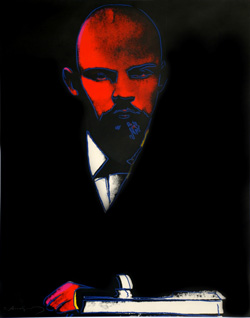 |
|
Artist |
Andy Warhol |
|
Title |
Lenin |
|
Medium |
Screenprint on Arches 88
paper. |
|
Year |
1987 |
|
Size |
39.375" x 29.5" |
|
Edition |
Edition of 120 ( 19/120 ), 24 AP, 6
PP, 10 HC, signed and numbered in pencil lower
left. There are 46 TP signed and numbered in
pencil as noted above. |
|
Misc. |
Printer: Rupert Jasen Smith,
New York
Publisher: Galerie Bernd Klüser, Munich, Germany |
PRICE : 110.000,- USD |
|
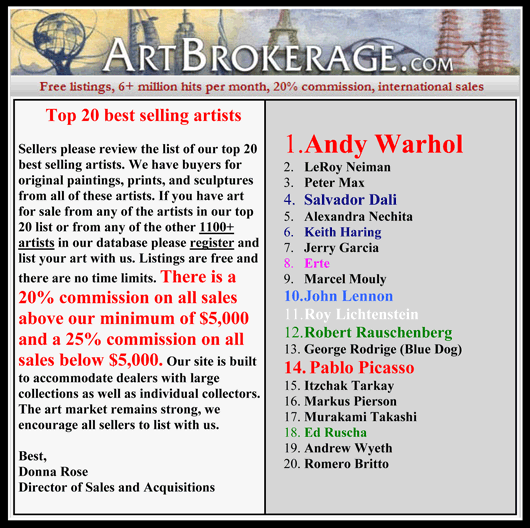
|
Andy
Warhol + Dano Brogyányi
USA + SK
FUJIFILM
galéria/FUJIFILM gallery
Vernisáž:
2. 7. 2008, 18.30/ exhibition opening: the July 2nd,
2008 at 6.30 p.m.
Diela
zapožičané zo zbierok Warhol Partners Gallery, člena
Spoločnosti Andyho Warhola v Medzilaborciach, Slovenská
republika / Courtesy of the Warhols Partners Gallery,
member of the Andy Warhol Society in Medzilaborce,
Slovak republic
Kurátori:
Dr. Michal Bycko, PhD., Mgr. Martin Cubjak / Curators:
Dr. Michal Bycko, PhD., Mgr. Martin Cubjak
Organizuje FOTOFO / Organised by FOTOFO
Adresa /
Address: Prepoštská 4, Bratislavawww.sedf.sk
otvorené
denne okrem pondelka 13.00 – 18.00 / open daily from
tuesday
to sunday 1 p.m. – 6 p.m.
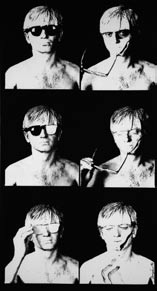 |
At the time
when in the USA the Abstract Expessionism was on its
decay as well as the idea of an artist being the highest
shaman and a great intelectual, a new „hunger“ for a
light, cheap, sweat... consume and art perception arouse
in the fed up American society. A new space was created
to be filled in by artists working at the beginning of
the 60’s and 70’s in Europe and the USA with a big „ART“
and even a bigger „POP“. In the foreground, there stood
a simple manipulation with those who were literally
asking for it. In the foreground, there stood artists
demonstrating such a manipulation to people by means of
art. In the foreground, there stood artists which joined
a movement called pop-art by their personal artistic
projects. Andy Warhol became soon a personality of the
biggest artistic profile in Pop Art. His heritage has
prepared a ground for a creative ambition of artists
overstapping not only his message, but also his huge
creative potention in multimedia. Daniel Brogyányi
follows this heritage probably the most obvious and
intensive way in Slovakia. He is an artist on the border
between the seriousness of expression and the banality
of topic. His overstapping of Warhol’s pop-art idea to
impose a seriousness and dignity in banality makes it
the most evident. Instead, Brogyányi inserts banality
and morbidity into seriousness within Post Pop Art.
While the portraits by Andy Warhol capture famous
personalities in different edition and colour variation,
the portraits by Daniel Brogyányi capture famous
personalities in regard to an ironic depiction of
his-her character (Peter Lipa (in English the last name
can be transalted as lime tree) portrayed with a lime
flower atc.). Of course, overstapping a simple artistic
heritage by editing or reinterpretation in the form of
portrait is not new. However, by Brogyányi there is a
novelty in the pureview of searching for new parallels
and similarities; the pureview of searching for a
percipient which looks for and brings in that necessary
and essential moment of a permanent non transparency and
the creative aspect of being unfinished in art. His
destructive treatment of flora and faun through means of
computer is also interesting. He does not describe or
interpret; he shows us these objects in circumstances
suggesting entirely new or scarce conotations.

Mgr. Martin
Cubjak curator MMUAW
|
|
The writer Michal Šmajda enters the encyclopaedia of
personalities “WHO’S
WHO”
On April 29th, 2008, after a proposal by
The Andy Warhol
Society in
Medzilaborce, WHO’S WHO WORLD SOCIETY
CORP., PANAMA, branch Personenenzyklopädien AG, Zug in
Switzerland included Michal ŠMAJDA, a Rusyn writer,
ethnographer, folklorist and anthropologist in its encyclopaedia
among other personalities of academic, political, economical,
cultural and artistic life of the society.
The Andy Warhol
Society
congratulates Michal Šmajda on the occasion of this world honour
and wishes him a lot of further creative inspiration and
success.
Dr. Michal BYCKO, Ph.D., F. A .B. I.,
2. 6.2008
 |
|
Six of Warhol’s paintings sold for 31.199.000 USD in an auction
On May 14th, 2008, SOTHEBY’s
international auction company held an auction in New York
selling works of those artists who have been productive since
the 1950s. According to the auction statistics, 85 works in
total were sold for 362.037.000,- USD. The most expensive
painting sold at the New York auction was TRIPTYCH by FRANCIS
BACON, for which an art collector paid 86.281.000,- USD. Some
works by ANDY WARHOL, the king of pop-art, were also among those
sold for over 1 million American dollars, in some cases the
actual selling price was several million higher than the
recommended price. Six of Warhol’s works were sold for a total
amount of 31.199.000,- USD. Another 35 works of art by Andy
Warhol were sold on May 15th, 2008 as part of an
auction on the occasion of Modern Art Day in New York.
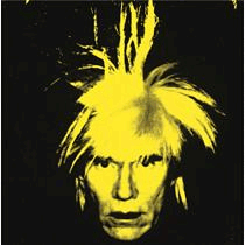
LOT 11
ANDY WARHOL
1928-1987
SELF-PORTRAIT
Lot
Sold. Hammer Price with Buyer's Premium: 3,065,000 USD
MEASUREMENTS 21 7/8 x
21 7/8 in. 55.6 x 55.6 cm.
DESCRIPTION acrylic
and silkscreen ink on canvas
Executed in 1986, this work is
stamped twice, initialled by Vincent Fremont and numbered
P040.049 on the overlap; also stamped on the reverse.
PROVENANCE
Estate of the Artist
Andy Warhol Foundation for the Visual Arts, New York
Stellan Holm Gallery, New York
Acquired by the present owner from the above in May 2001
EXHIBITED
Greenwich,
Bruce Museum, Pleasures of Collecting: Part II. 20th Century
and Contemporary Art, January - April 2003
next
 |
|
New York, Pittsburgh.....Medzilaborce? Not generally
known as a pop art barometer, this backward outpost of
northeastern Slovakia has more in common with communism than
consumerism. So when a museum dedicated to art-legend Andy
Warhol was founded here a few years ago, it caused quite a
sensation -- and not a little controversy.
Born in Pittsburgh to Czechoslovakian immigrant
parents, Andy Warhol (1928-1987) never put much stock in his
family background. When asked where he was from, the elusive
artist once quipped, "I come from nowhere." Yet, thanks to the
Medzilaborce museum, "nowhere" is fast becoming a place of
pilgrimage for Warhol fans in search of the artist's Eastern
European roots.
"Everyone knows about Andy Warhol, superstar," says Michal
Bycko, a high school art teacher who, along with Andy's brother,
John Warhola, and the Warhol Foundation in New York, established
the museum not far from the birthplace of Warhol's mother,
Julia. "We want to show that there is another side to his
persona: Andy Warhol, the boy from Ruthenia."
by
Robert Rigney
NEXT
 |
|
There
is a curious postcard on sale at the Andy Warhol Museum of
Modern Art at Medzilaborce, in northeastern Slovakia. It shows
the American Pop artist pushing his bike down the town's slushy
main street. With his trademark silver-white hair, Warhol looks
slightly out of place amid the communist-era low-rises lining
the street.
For a good reason. Though his parents emigrated from the area in
the early 1900s, Pittsburgh-born Warhol never visited Slovakia,
much less Medzilaborce, a remote town of 6,500. But that has not
stopped the locals, few of whom had ever heard of Warhol or Pop
art before 1989, from adopting him as one of their own. "If you
want to know Andy Warhol the superstar, go to Pittsburgh," says
Michal Bycko, the museum's curator. "But if you want to know him
as a person and what he was like before he became famous, you
need to come to Medzilaborce."
The region is an unlikely setting for the world's second-largest
museum dedicated to Warhol's work and life (Pittsburgh has the
biggest). It is a forgotten land of mountains, storks,
scarecrows and industrious people — a quarter of whom are
unemployed — struggling to adjust to post-communist life. "It's
so strange to find Warhol here, in the middle of this nowhere,"
says Heiko Schramm, 36, a visitor from Chemnitz, Germany.
Monday, Jul. 29, 2002
By
JAN STOJASPAL/MEDZILABORCE
NEXT
 |
|
A man from nowhere
A man from nowhere, a man present anywhere yet always stays
at the background. Andy Warhol was born on 6th August 1928
v Pittsburg. He was born the son of Ruthenian parents from
Miková, which lies on the eastern part of the Slovakia. He
enforced a new of expression of the artistic idea in the art
thus becoming the Superstar, the king of Pop-art and also
a cult personality of art and life of the 20th century.
Reporter of the era, portrait painter of society, graphic
artist, drawer, photographer, filmmaker, author of
theatrical performances and autobiographical letters,
producer and manager of rock music, publish of the magazine
Interview and ultimately the leading personality of the
(in)famous Factory in the very heart of New York. The
artists who tried an confirmed his own life-long concept of
presenting the mundane motifs and eccentric pictures of
snobbish and consumerist society without actually destroying
his reputation as a person with a crucial status in American
society as a cultural scene celebrity. He was both unusual
intellectual eccentric and mysterious person confirming his
image by numerous ambiguous statements about himself, his
art and life. If you want to know everything about me, look
at the surface of my pictures, movies and my person: ´´That
is me, there is nothing hidden underneath them.´´ Andy
Warhol expressed himself. He produced a great number of
thematic works of art using the screen printing technique.
They seem to be visually very obvious and comprehensible,
but their background has got a very elaborate logical
structure of their motive. At analysing the majority of his
daunting metaphors we find out that the visual content of
his works is imbued with hidden implication but nevertheless
carries along with it a barrier, which nullifies these
derived meaning thus exposing his true intentions.
NEXT
Martin CUBJAK, M.A.,
14. 1. 2008 |

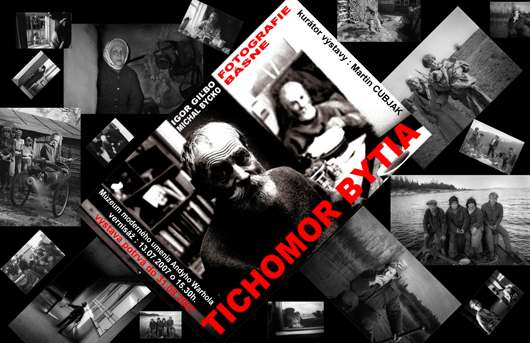 |
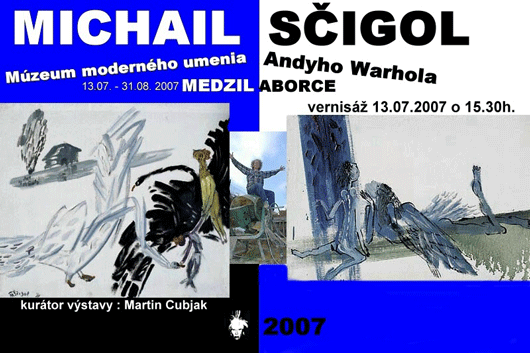 |
|
GREEN
CAR CRASH
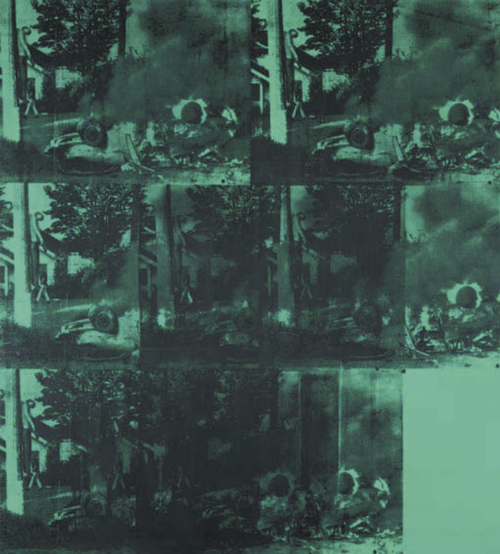
Sale Date May 16, 2007
Lot Number
0015
Sale Number
1834
Creator
Andy Warhol (1928-1987)
Lot Title Green Car Crash
(Green Burning Car I)
Estimate 25,000,000 - 35,000,000
U.S. dollars
Price Realized
71,720,000,- U.S. dollars
Green Car Crash (Green Burning Car I)
synthetic polymer, silkscreen ink and acrylic on linen (
canvas)
90 x
80 in. (228.6 x 203.2 cm.)
Painted in 1963.
Provenance : Galerie Ileana Sonnabend, Paris
Gian Enzo Sperone Arte Moderna, Turin
Remo Morone, Turin
Anon. sale; Christie's, London, 6 December 1978, lot 229
Galerie Bruno Bischofberger, Zurich
Acquired from the above by the present owner
Literature Andy Warhol, exh. cat., Institute of
Contemporary Art, Philadelphia, October-November 1965, no. 4
(illustrated).
D. Antin, "The Silver Tenement," Art News, vol. 65, no.
4, Summer 1966, p. 47 (detail illustrated as Disaster).
A. Boatto, Pop Art in USA, Milan, 1967, p. 217
(illustrated).
M. Compton, Pop Art, London, 1970, no. 107 (illustrated).
R. Crone, Andy Warhol, New York, 1970, no. 326
(illustrated in color).
O. Hahn, Warhol, Paris, 1972, p. 60 (illustrated).
S. Wilson, Pop, London, 1974, no. 11 (illustrated in
color as Green Disaster).
R. Crone, Das Bildnerische Werk Andy Warhols, Berlin,
1976, no. 764 (illustrated).
A. Boatto, Pop Art, Rome, 1983, no. 20 (illustrated in
color).
J. Hendrickson, "Andy Warhol," Nike, vol. 5, no. 20,
October/November 1987, p. 24 (illustrated).
D. Bourdan, Andy Warhol, New York, 1989, p. 38, pl. 134
(illustrated in color).
K. Honnef, Andy Warhol 1928-1987, Cologne, 1989, p. 53
(illustrated in color).
Art e Dossier, no. 105, 1995, p. 38 (illustrated in
color).
A. Zaera, "Zwischen Geischt und Landschaft," Arch +, nos.
129-130, December 1995, p. 101 (illustrated).
G. Frei and N. Printz, eds., The Andy Warhol Catalogue
Raisonné of Paintings and Sculptures 1961-1963, vol. 1, New
York, 2002, pp. 385 and 388, no. 425 (illustrated in color).
ExhibitedParis, Galerie Ileana Sonnabend, Warhol,
January-February 1964 (illustrated).
Turin, Gian Enzo Sperone Arte Moderna, Warhol, February
1965 (illustrated).
Turin, Galleria Civica d'Arte Moderna, New Dada e Pop Art
Newyorkesi, 1969, no. 73 (illustrated).
Pasadena Art Museum; Chicago, Museum of Contemporary Art;
Eindhoven, Stedelijk van Abbemuseum; Musée d'Art Moderne de la
Ville de Paris; London, Tate Gallery and New York, Whitney
Museum of American Art, Andy Warhol, May 1970-July 1971,
no. 18 (Paris, no. 59, London, no. 98).
Kunsthaus Zurich, Andy Warhol, 1978, no. 76
(illustrated).
Kunstmuseum Thun, Das Auto in der Vitrine, July-August
1985.
Kunstverein Hamburg, Andy Warhol, October-December 1987,
no. 5 (illustrated in color).
Kunstmuseum Lucerne, Andy Warhol Paintings: 1960-1986,
July-September 1995, no. 12 (illustrated in color).
Riehen/Basel, Fondation Beyeler, Andy Warhol: Series and
Singles, September-December 2000, pp. 99 and 196, no. 45
(illustrated in color).
Lot NotesThe Car Crash paintings that Warhol made between
late 1962 and early 1964, form the most varied and extensive
group of pictures in his seminal series of Death and Disaster
paintings. Drawing on six different documentary source
photographs each outlining six separate, horrific and
increasingly bizarre fatal accidents, Warhol's Car Crashes
remain among the most powerful, challenging and provocative
paintings made by any artist in the Post-War era.
Green Car Crash (Green Burning Car I)
is one of the masterpieces from this series. It is an
unforgettable painting that makes multiple use of what is
arguably the most extraordinary, strange and disturbing source
image of all those used in Warhol's famous Death and Disaster
paintings. Describing more than just the scene of a car crash,
this large electric green colored painting is a haunting work
whose macabre and endlessly puzzling imagery startles with its
stark and repetitive photographic presentation of a mundane
suburban street shockingly transformed into a horrific disaster
scene bordering on that of a surrealistic nightmare.
Silkscreened over a phthalo green background, Green Car Crash
(Green Burning Car I) is a unique, seemingly mechanically
colored work that belongs to a series of five paintings all made
in the summer of 1963 and once known as the "burning car"
paintings, that use the same source photograph. The other four
paintings, White Disaster I (Staatsgalerie Stuttgart),
White Disaster II (Museum für Moderne Kunst Frankfurt am
Main), White Burning Car III (Andy Warhol Museum,
Pittsburg) and the smaller image, White Burning Car Twice,
are all executed solely in the newsprint-like tones of black and
white. The extraordinary source image used by all these imposing
and famous pictures was taken by photographer John Whitehead and
inserted, apparently arbitrarily, into an article on racial
integration that appeared in the June 3 issue of Newsweek
in 1963. The caption that accompanied the photograph in the
magazine described the photograph and the scene it records as
follows: "End of the Chase: Pursued by a state trooper
investigating a hit-and-run accident, commercial fisherman
Richard J. Hubbard, 24, sped down a Seattle street at more than
60 mph, overturned, and hit a utility pole. The impact hurled
him from the car, impaling him on a climbing spike. He died 35
minutes later in hospital."
The photograph used in these paintings describes therefore, a
freak accident. Like the black irony implicit behind Warhol's
later Ambulance Disaster paintings showing the horrific
and fatal result of a collision between two ambulances returning
from the same crash scene, or the terrifying and almost comic
minimalism of Foot and Tire, one of the key features of
Green Car Crash (Green Burning Car I) is the truly
strange and exceptional nature of its imagery. In one freakish
instant, a peaceful suburban street has been transformed into a
horrifying scene of hell. It was this truly unique moment of
reality, this peculiar moment of transition, when all values
were transformed, life extinguished into death, the banal and
the mundane into the exceptional and extraordinary - that
particularly fascinated Warhol in many of the Car Crash
images he chose, captivating his imagination at precisely the
same time that it also terrified him. As David Bourdon has
recalled, all throughout his life Warhol had an acute terror of
unpredictable and indiscriminate death - something which, by his
own admission led to such things as a perpetual and irrational
fear of the driver of whatever car he happened to be in falling
asleep at the wheel. Deeply conscious of the ever-presence of
death, Warhol was mesmerised by the shallow fleeting transience
of life and the thin, fragile intensity of reality - the way in
which things could be here one minute and gone the next.
Something of this existential transience is implicit within the
shallow photographic realism Warhol offered up in his paintings
through the silkscreen technique. It is an element that is
particularly emphasized in his Death and Disaster series
and nowhere more so than in the "burning car" crash pictures
such as Green Car Crash (Green Burning Car I).
Following on perhaps, from his painting Suicide (Fallen Body)
in which a woman's body lies amidst the crumpled wreckage of the
car she had fallen onto, in Warhol's first great Car Crash
paintings, Green Disaster 2 (Museum für Moderne Kunst,
Frankfurt am Main) and Orange Car Crash 14 Times (MoMA,
New York) for example, the artist's concern was with the bizarre
and horrifying intermingling of mangled human bodies and
crumpled metal. It is in these paintings that Warhol first
displays his interest in transforming, through a pattern of
repetition, horrific reality into an abstraction - one which he
later likened to being like "dress fabric." "When you see a
gruesome image over and over again," Warhol told Gene Swenson at
the time, "it really doesn't have any effect" (Andy Warhol cited
in "Interview with Gene Swenson," Art News, New York,
November 1963).
Using the shallowness and apparent objectivity of the
photographic image and the ease of repetition provided by the
silkscreen process, Warhol sought in these works to explore the
power and potency of such horrific images of man merged with
machine. Running the same image repetitively across a brightly
colored monochrome canvas in such a way that the eye becomes
accustomed to its sequential and even patterned rhythm or play
of form, Warhol not only sanitizes his imagery and makes it
familiar, but he abstracts it, transforming its horrific and
shocking power into something banal and vacant. In subsequent
Car Crash images, such as 5 Deaths, it is less the
abstract and more the strange, bizarre, almost unreality of the
photographic image and the accident itself, that appears to
capture Warhol's attention and which his paintings focus upon.
Verging on surrealism, Green Car Crash (Green Burning Car I)
is the ultimate example of this other tendency in Warhol's
Car Crash paintings. Like something from David Lynch's
Twin Peaks or Blue Velvet, where the charming and
banal idyll of a suburban community is shown to be nothing more
than a shallow artifice of respectable surface appearance
beneath which there lurks a darker reality of horror and
depravity, Green Car Crash (Green Burning Car I) reveals
a very real but similar rift in the world of appearances. And it
does so with all the gritty realism and mechanical style of an
illicit movie or a film noir.
What is most remarkable about the source image used in Green
Car Crash (Green Burning Car I) and what distinguishes it
from all other of the Car Crash images is the startling
contrast that it reveals in its foreground and background. In
the foreground of the painting Richard Hubbard's overturned car
lies in flames, while his body, impaled on a post at the left of
the picture, hangs limp, though still in fact alive, in a manner
that has prompted several critics to mistake the image as one
depicting a lynching in the Deep South. This horrific and
extraordinary scene is displayed with the apparent calm
detachment and documentary objectivity of a real estate
photograph or image from a holiday brochure. Composed in such a
way that the pole on which, the dying Mr. Hubbard is impaled,
intersects the picture frame roughly in accordance with
classical rules of landscape painting and so as to balance the
dramatic horizontal of the burning car, the eye of the
photographer has, unconsciously no doubt, fitted the physical
details of this tragedy into a standard and visually pleasing
formal arrangement. Something of the stability and calm of the
composition is reiterated by the background scenery in which the
sleepy suburban landscape, remains seemingly undisturbed and
unchanged by the horrific incident taking place in the
foreground. At the heart of this is the nonchalant figure of a
man, hands in his pockets, seemingly unconcerned, sauntering
past the scene on the other side of the sidewalk. He is
apparently oblivious to the nightmare of death and destruction
taking place only a few yards away from him.
This extraordinary contrast, captured in this photograph,
between the mundane normality of everyday suburbia and the
exceptional violence and tragedy that periodically strikes at
its heart pictorially describes exactly what Warhol wished to
express in the Death and Disaster series about the
extraordinary tragedies and horrors occurring to ordinary people
on a daily basis. Extraordinary tragedies and events that 'go
by', Warhol said, completely unnoticed. It was no doubt for this
reason that, in this work alone of the five 'burning car' crash
paintings, Warhol has concentrated on the specific part of the
photograph showing the impaled figure and the passer-by,
repeating this segment of the source photo in a triple sequence
both at the centre and in the bottom row of the painting.
Emulating the effect of a stuttered filmic sequence, this
film-shutter-like run of repeated imagery, throws the horror of
the impaled man and the extraordinary complacency of the
nonchalant figure strolling past him straight at the viewer in
an almost accusatory way. Can we, the spectator, the painting
seems to ask, really adopt a similarly blind attitude to such
horror as that of the walking man going on his way oblivious to
all around him? Here, the rippled emphasis of the repeated image
does not diffuse the horror of the painting's imagery but
compounds it. The fact that this painting was made at a time, in
the early 1960s, when political conscience was becoming a
central question of the New York intelligentsia only makes this
image more prescient and indicative of its time. Indeed, in
Warhol's hands, such is the power of this weird, banal and
horrifying image to invoke questions about the moral complacency
of a middle-class America that it seems more than coincidence
that it was made at precisely the same time that Hannah Arendt's
report on the 'Banality of Evil' was being serialised in the
New Yorker magazine.
Painted sometime in either June or July of 1963, Green Car
(Green Burning Car I) was one of the first paintings that
Warhol made with the help of his new assistant Gerard Malanga.
It was made as part of Warhol's preparation for his winter show
at the Sonnabend Gallery in Paris. This exhibition Warhol
originally intended to be called "Death in America," and was to
include images of the darker side of the U.S. in the aim of
pleasing the French intellectuals whom Warhol had been led to
believe would not welcome his earlier "Pop" images drawn from
the country's overtly consumerist culture. With its central
image of disaster taking place in the heart of an all-American
suburban landscape, Green Car Crash (Green Burning Car I)
was one of the key paintings to be exhibited at this exhibition
which subsequently opened to much acclaim in Paris in January
1964.
Like so much of Warhol's work Green Car Crash (Green Burning
Car I) is a deeply incisive mirror of its time. Much more
than a painting of a mere road accident, the painting with its
sequential progression of silkscreened images seeming like razor
thin slices of reality laid and overlaid upon one another, seems
to present a panoply of mayhem and violence taking place in the
suburban heart of America. Anticipating the troubled and
turbulent path that middle-America would take throughout the
1960s, the painting is, like much of Warhol's work, deeply
prophetic in the sentiments and atmosphere it projects.
Calvin Tomkins once described Warhol as "a rather terrifying
oracle" who, in the 1960s, "made visible what was happening in
some part to us all" ("Raggedy Andy" by Calvin Tomkins cited in
Andy Warhol, exh. cat., Van Abbemuseum, Eindhoven. 1970.
p. 10). Green Car Crash (Green Burning Car I) is a work
that reveals Warhol seeming to stare at the synthetic surface of
reality and peeling its layers off to reveal a deeper and more
disturbing truth lying beneath it. Like veils or synthetic
screens of reality, the layered images that combine to form this
extraordinary painting seem to outline an innate and disturbing
division underlying even the most mundane, ordinary and
respectable reality. The more you look, the painting seems to
suggest, the more things are not what they seem. It is the same
sentiment that Warhol returned to when talking about suburban
America in his 1985 book entitled America.
"You see houses everywhere, the green lawns with the sprinklers,
the jungle gyms in the backyards, the kids riding their bikes to
school, the mailman coming by with a smile, a woman unloading
bags of groceries from her station wagon, and you can't help but
think, 'This is the real America.' You imagine that everyone
around who you haven't seen in a long time is living this very
regular humdrum life that's peaceful...But then you start
learning the details. You find out the nice man who always had
an extra piece of gum to give you has gone completely off his
rocker and killed his wife, that the ex-minister of the church
you grew up in is now a big drunk who's totalled three cars. You
learn that your best friend's parents who were always so great
are getting a divorce, that the woman who you always thought the
most ordinary housewife ran off with another man from Canada.
You find out that the girl you had a crush on in elementary
school is now a religious fanatic living in India with a bald
head...Nobody in America has a normal life" (Andy Warhol cited
in America, New York, 1985, p. 176).
 |
|
Artist
Andy Warhol
Title
Cowboys and
Indians; Kachina Dolls
Medium
Screenprint on Lenox
Museum Board.
Year
1986
Size
36" x
36"
Edition
Edition of 250, 50 AP, 15 PP, 15 HC, 10 numbered in Roman
numerals, signed and numbered in pencil lower left. There are 36
TP signed and numbered in pencil, containing the following four
addirional prints: War Bonnet Indian, Buffalo Nickel, Action
Picture, and Sitting Bull. The TP of Kachina Dolls are signed
and numbered in pencil lower right.
Printer: Rupert Jasen Smith, New York
Publisher: Gaultney, Klineman Art, Inc., New York
PRICE:
36.000,-USD
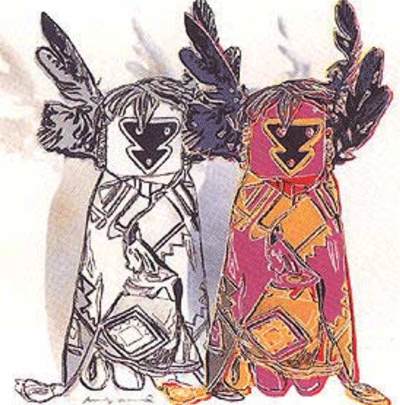
Artist
Andy Warhol
Title
Marilyn Monroe
Medium Screenprint on white paper.
Year 1967
Size 36" x 36"
Edition
Edition of 250, signed in pencil and numbered with rubber
stamp on verso; some signed in ball-point pen;some only
initialled on verso; some dated. There are 26 AP, signed and
lettered A-Z on verso.
Misc.
Portfolio of 10 screenprints.
Printer: Aetna Silkscreen Products, Inc./Du-Art Displays,New
York
Publisher: Factory Additions, New York
PRICE:
2.320.000,-USD
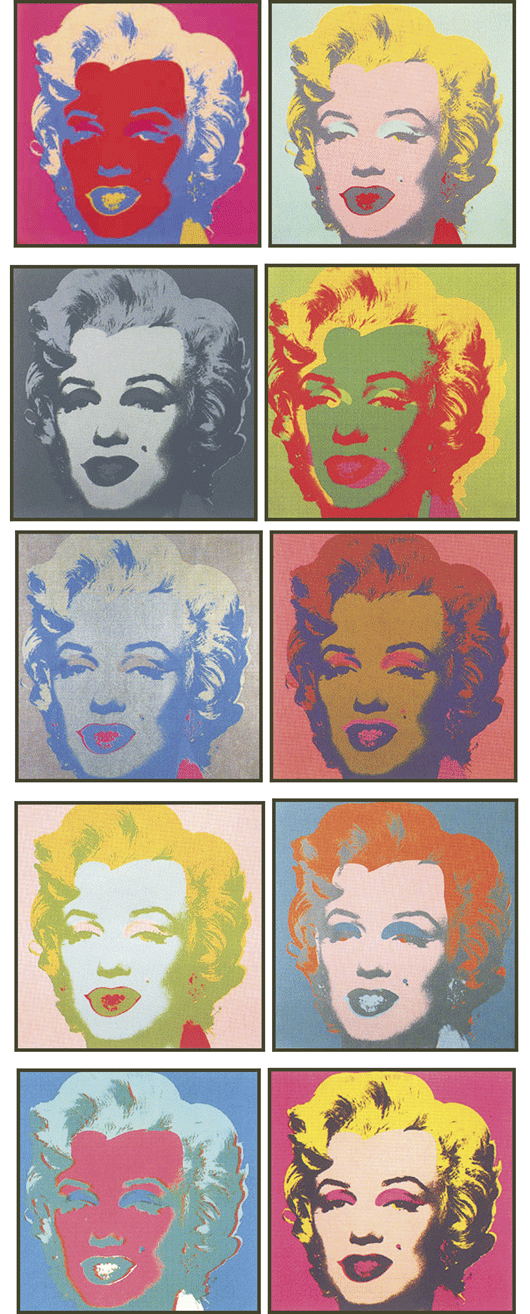
Artist
Andy Warhol
Title Ladies and Gentlemen
Medium Screenprint on Arches paper.
Year
1975
Size 43.5" x 28.5", image approx. 33.5" x 26.5"
Edition
Edition of 125, 25 AP, 1 PP,signed, numbered and dated '75 in
pencil on verso.
Misc.
Portfolio of ten screenprints.
Printer: Alexander Heinrici, New York
Publisher: Luciano Anselmino, Milan, Italy
PRICE: 100.000,-USD

Artist
Andy Warhol
Title
Campbell's Soup II
Medium
Screenprint on white paper.
Year
1969 Size 35" x 23"
Edition
Edition of 250, signed in ball-point pen and numbered withrubber
stamp on verso. Ther are 26 AP, signed and lettered on verso.
Misc.
Portfolio of 10 screenprints.
Printer: Salvatore Silkscreen Co., Inc., New York
Publisher: Factory Addition, New York
PRICE ( portfolio ) : 460.000,-USD
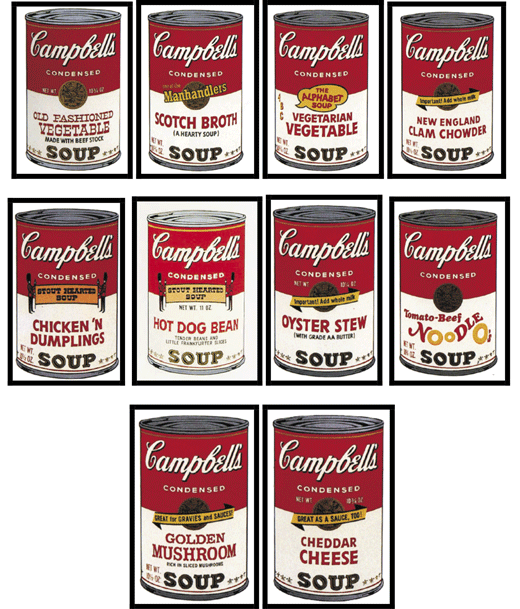
Artist
Andy Warhol
Title
Kimiko
Medium
Screenprint on Stonehenge paper.
Year
1981
Size
36" x 36"
Edition
Edition of 250, 50 AP, signed and numbered in pencil on verso.
Misc.
Published to raise funds for a special Visual Arts Program
sponsoring visiting artists and exhibitions at Colorado State
University.
Printer: Licht Editions, Ltd., Denver
Publisher: Colorado State University, Department of Art, Fort
Collins
Price: 25. 000,- $
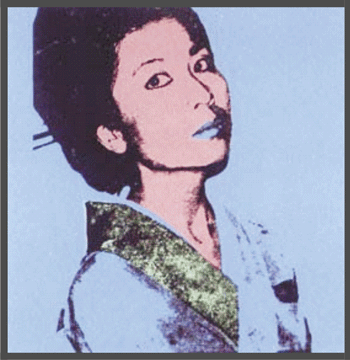
Artist
Andy Warhol
Title
Cowboys and Indians; Northwest Coast Mask
Medium
Screenprint on Lenox Museum Board.
Year
1986 Size 36" x 36"
Edition
Edition of 250, 50 AP, 15 PP, 15 HC, 10 numbered in Roman
numerals, signed and numbered in pencil lower right. There are
36 TP signed and numbered in pencil, containing the following
four addirional prints: War Bonnet Indian, Buffalo Nickel,
Action Picture, and Sitting Bull. The TP of Kachina Dolls are
signed and numbered in pencil lower right.
Printer: Rupert Jasen Smith, New York
Publisher: Gaultney, Klineman Art, Inc., New York
PRICE: 25.OOO,-USD
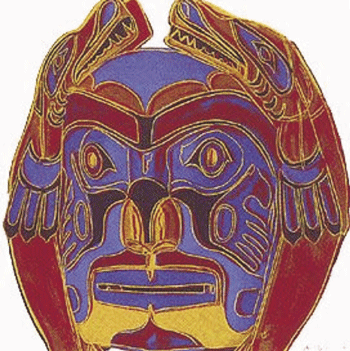
|
|
In
the last year, the value of Andy Warhol´s works
has increased by
50 - 200 %.
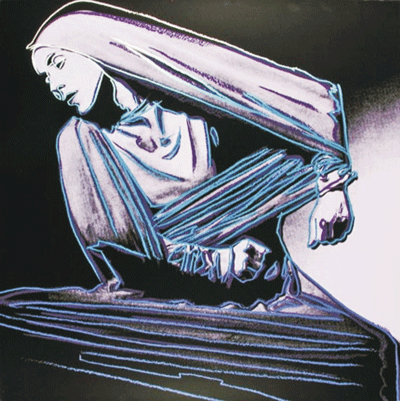
Andy Warhol,
Lamentation #388 (Martha
Graham), hand-signed
screenprint, image size: 36 x 36 inches,
gallery pricing: $24,850

Andy Warhol,
Madonna & Self-Portrait with
Skeleton's Arm (After Munch), 1984, unique screenprint,
image size: 32 x 40 inches, gallery
pricing: $98,500
 |
|
Ivan
Gašparovič is the first president to visit an exhibition opening
of Andy Warhol’s works
|
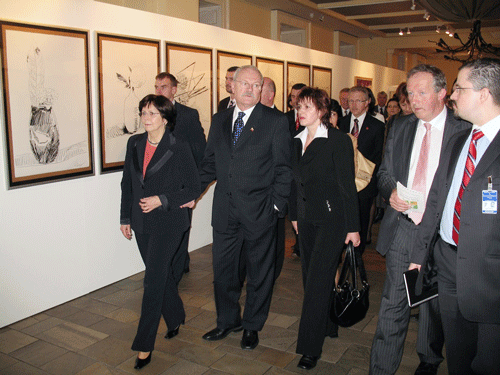 |
|
In the picture by M. Sirík (from the left): the first
lady of the Slovak Republic Sylvia Gašparovičová; Ivan
Gašparovič, the President of the Slovak Republic; Valika
Maďarová, the Director of the Andy Warhol Museum of
Modern Art and other guests looking at Andy Warhol’s
works at the gala opening of the exhibition in Dublin. |
|
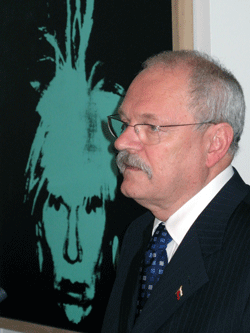 |
|
President Ivan Gašparovič at the gala opening of an
exhibition showing works by Andy Warhol, a
world-known artist of Rusyn descent, in Dublin, the
capital of Ireland, on March 27th, 2007
(in the background, the most famous portrait by Andy
Warhol)
Photo: Miroslav Sirik |
On March 27th, 2007 in the Dublin Castle museum in
Ireland, the President of the Slovak Republic, Ivan Gašparovič,
opened an exhibition of Andy Warhol’s works.
The exhibition was curated by Dr. Michal Bycko, PhD. and Mgr.
Martin Cubjak and prepared by the Andy Warhol Museum of Modern
Art (AWMMA) and the Andy Warhol Association in Medzilaborce, in
cooperation with the Embassy of the Slovak Republic in Ireland.
President Ivan Gašparovič, according to available sources, is
the first president of a sovereign state outside of the USA, to
personally take part in an exhibition opening of work by this
significant artist of the second half of the 20th
century. The fact that the roots of this uncrowned king of
pop-art lie in Slovakia, in the Rusyn village of Miková (from
where his Rusyn parents left to look for work in the USA) makes
it even more significant. The exhibition is entitled “ANDY
WARHOL – HIS SLOVAK ROOTS“
The exhibition will run until April 27th, 2007 and on
May 1st, 2007 will be reinstalled in the Cork Public
Museum.
Iveta RUSINKOVÁ,
Curator of AWMMA in Medzilaborce,
March 30th, 2007
 |
|
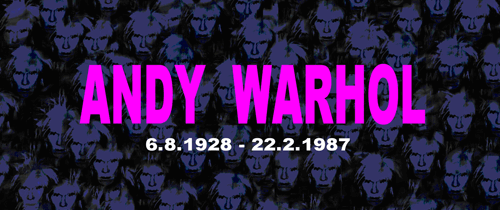
|
ANDY
WARHOL
LIFE AND ART WORK |
|
DUBLIN CASTLE
MARCH 27, 2007
–
APRIL 27, 2007
CORK PUBLIC MUSEUM
MAY 1, 2007
–
MAY 27, 2007 |
The
Embassy of the Slovak Republic
20 Clyde Road
Ballsbridge, Dublin
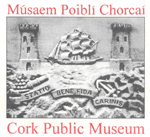
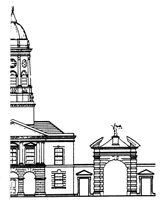 |
It is really
a special occasion to introduce to the Irish public the
work of Andy Warhol – a famous artist with Slovak roots.
After an exhibition dedicated to the world known
politician Mr. Alexander Dubček in Trinity College two
years ago and after the exhibition devoted to the life
of the founding father of Slovakia, a General of French
Army Mr. Milan Rastislav Štefánik in Aliance Francaise
in Dublin last year, we have now an unique opportunity
to bring to the Dublin Castle the spirit of the king of
pop art Andy Warhol. It is also our privilege to
highlight through this exhibition the first official
visit of the President of Slovakia His Excellency Ivan
Gasparovic to Ireland.
Little Andy was born to Slovak parents after they had
moved to the United States of America as millions of
other families did. The family of little Andy lived in
Pittsburgh where at the beginning of the last century a
very large community of Slovaks lived for obvious
reasons – picturesque landscape of Pennsylvania reminded
our Slovak grandparents of their Slovak homeland and
there was a lot of work opportunities – namely hard
work in the coal mines. After his studies of art at
Carnegie Mellon University in Pittsburgh young Andy
moved to New York where he started to develop fully his
creativity. Andy Warhol brought a very revolutionary
approach to all genres of art he had touched – painting,
sculpture, photography, music, film, fashion,
literature. He, somehow, tried to synchronize the art
with the modern time influenced by consumerism he lived
in – we may say he helped define that time. In 1960 he
founded the famous „Factory“, gathering around himself a
wide range of artists and friends like sir Mick Jagger,
Liza Minelli, John Lennon, David Bowie, Diana Ross,
Brigitte Bardot, later also Michael Jackson. Throughout
the decade it became more and more clear that there had
been profound change in the culture of the art world,
and that Warhol was at the centre of that shift. Let us
mention just a few of his famous works – Campbells Soup
Cans, Coke Bottles, Disaster painting and portraits of
celebrities like Mick Jagger, Marilyn Monroe and Elvis
Presley.
During his life Andy Warhol has achieved something that
many artists dream of but few get to. He became an icon
of a new brand of art – pop art. Some people say he was
weird, well from certain point of view he definitely
was. But it is not true that great artists create their
own world where our optic simply don´t match? Andy
Warhol became celebrity already during his lifetime also
thanks to his popular quotes. He said that „In the
future everyone will be world-famous for 15 minutes“.
Well, this maybe true for everyone but surely not for
Andy Warhol, his world fame has definitely exceeded 15
minutes.
Ten years ago, during my posting at the Embassy of
Slovakia in the US, when I visited Andy Warhol Museum in
Pittsburgh – the largest American art museum dedicated
to a single artist - I told myself it would be nice to
promote the Slovak roots of the king of pop art. Several
years later after Slovakia had joined European Union
during Irish presidency I promised to my Irish friends
to bring Andy Warhol to this beautiful country. I am
very pleased that we have got this exhibition here and
that we can extend the exhibition also to the City of
Cork that gave a warm welcome to my country on its way
to the Union.
Ján Gábor
Ambassador
of Slovakia in Dublin

|

ANDY WARHOL
Andy Warhol was born
Andrew Warhola on August 6, 1928, in a two-room shack-like apartment at
73 Orr Street in the working class neighborhood of Soho in Pittsburgh,
Pennsylvania, to Andrej Warhola and Julia Zavacky Warhola. The youngest
of three sons, Andrew attended Holmes Elementary School and Schenley
High School, and entered Carnegie Institute of Technology (now Carnegie
Mellon University) in Pittsburgh in 1945, where he studied with Balcomb
Greene, Robert Lepper, Samuel Rosenberg, and others. He experimented
with his name, signing holiday cards "André," and dropping the final "a"
from his family name. He graduated in June 1949 with a Bachelor of Fine
Arts degree in Pictorial Design.
Soon after graduating, Warhol moved to New York City to pursue a career
as a commercial artist. His first work appeared in Glamour
magazine in September 1949. Throughout the 1950s, he became one of the
most successful illustrators of his time, and won numerous awards for
his work from the Art Directors Club and the American Institute of
Graphic Arts. His clients included Tiffany & Co., The New York Times,
I. Miller Shoes, Bonwit Teller, Columbia Records, Harper's Bazaar,
Vogue, Fleming-Joffe, NBC, and others. Much of his commercial
work was based on photographs and other source images, a process he
would use for the rest of his life. He also employed the delightfully
quirky handwriting of his mother Julia in many of his works in this
period. She won a professional award for her lettering on the LP The
Story of Moondog in 1958, and Warhol published a book of her
drawings, Holy Cats, in 1957. She was always credited as "Andy
Warhol's Mother." She left Pittsburgh in 1952 to join her son, and they
lived together until about 1971. Warhol painted memorial portraits of
her after her death; he also had made a film and shot videotapes of her.
|
|
 |
|
Credit: Hulton Archive/Getty Images |
In 1956 Warhol traveled
around the world for several weeks, visiting many countries in Asia and
Europe. In the late 1950s he began to devote more energy to painting. He
made his first Pop paintings, based on comics and ads, in 1961, and then
a series of Campbell's Soup Cans in 1962. These created a
sensation in the art world and launched Warhol as a celebrity. Except
for a brief period in the mid-1960s, he would continue to paint until
the end of his life. He also extended his talents into other fields such
as film, publishing, writing, television, and music. By the time of his
death, he was one of the most prolific and well-known artists the world
had ever seen.
Warhol had a life-long fascination with Hollywood. In 1962 he began a
large series of celebrity portraits, including Marilyn Monroe, Elvis
Presley, and Elizabeth Taylor. He also began his series of "death and
disaster" paintings at this time - images of electric chairs, suicides,
and car crashes.
In 1963 he began to make films, and created many classics of avant-garde
cinema over a five-year period, including Sleep (1963),
Empire (1963), Kiss (1963-64), and The Chelsea Girls
(1966). Warhol made about 600 films from 1963 until 1976, ranging from
almost 500 short Screen Tests (4-minute portrait films, from
1963-1966), to **** (a/k/a Four Stars, 1967-68), a
twenty-five-hour long film. Between 1968 and 1976, Paul Morrissey
directed most of his films, while Warhol was the producer.
Warhol's first exhibition of sculptures was held in 1964, with hundreds
of replicas of large supermarket product boxes, including Brillo
Boxes, Heinz Boxes, Del Monte Boxes, Mott's Boxes, and
Kellogg's Boxes. By this time, his new studio, painted silver and
known as the Factory, was becoming the place to be in New York; parties
held there were mentioned in gossip columns throughout the country. By
the mid-1960s he was a frequent presence in magazines such as
Newsweek, Time, and Esquire.
In 1965, Warhol was the first artist to exhibit video as art. He loved
its immediacy, and eventually filled about 2500 videotapes, including
Factory Diaries, Phoney, and others.
At an exhibition of his Flowers paintings in Paris in 1965, Warhol
publicly announced that he was retiring from painting to pursue
filmmaking, although he continued to make editions of fine art prints,
and also sculptures. However, he began painting again in 1966. He
broadened his activities into the realm of performance art with a
traveling multimedia show called The Exploding Plastic Inevitable,
which featured the rock and roll band The Velvet Underground. The EPI
has been credited by some with the invention of the psychedelic light
show as nightclub entertainment. The Velvet Underground went on to
become one of the most influential rock bands in history. During this
time, Warhol briefly operated a dance club in Manhattan called the
Gymnasium, which featured exercise equipment on the dance floor.
In 1966 Warhol exhibited Cow Wallpaper and Silver Clouds
at the Leo Castelli Gallery. The Cows were Day-Glo colored, and the
Clouds were floating silvery balloons shaped like pillows. Warhol
covered the exterior of Stockholm's Moderna Museet with Cow
Wallpaper in 1968.
On June 3, 1968, Valerie Solanas, a writer who had appeared in Warhol's
film I, a Man (1967), came into the studio and shot Warhol in
the chest, apparently because of a play she had written. He recovered
from the near-fatal shooting after a five-hour operation. While
recuperating he painted a large series of portraits of Happy Rockefeller,
the wife of the Governor of New York.
|
|
 |
|
Andy Warhol and Mario Montez on the set of "Chelsea Girls"
Credit: Hulton Archive/Getty Images
|
Warhol self-published a
large series of artist's books in the 1950s, but his first mass-produced
book, Andy Warhol's Index (Book), was published in 1967. He
later published a, a novel (1968), Blue Movie (1970),
THE Philosophy of Andy Warhol (From A to B and Back Again)
(1975), POPism (1980), Exposures (1979),
Children's Book (1983), and America (1985). Party Book
(1988), and The Diaries of Andy Warhol (1989) were published
posthumously, with the latter becoming a scandalous best-seller.
Beginning with a, the technique for most of his writings was
transcribed recorded conversations. This method was also used for
Warhol's stage play, Pork, produced in London and New York in
1971. In total, he recorded about 3400 audiotapes.
Warhol closed the 1960s with an unusual exhibition, Raid the Icebox
I, which he was invited to choose from the collection of the Rhode
Island School of Design's museum. Rather than the usual masterpieces,
Warhol chose damaged paintings in the process of being repaired, the
entire collection of historical footwear and parasols, and other
unexpected items. At the time, he was developing a very keen eye for
antiques; among his discoveries were French Art Deco designs, Native
American blankets and pottery, and American Folk Art and cookie jars.
Also in that year he co-founded Interview, a magazine devoted
to film, fashion, and popular culture that continues to this day.
Warhol's quote, "In the future everybody will be world famous for
fifteen minutes," is known throughout the world, and originated in about
1967 or 1968. Interview testified to Warhol's lifelong
obsession with film stars and other contemporary celebrities.
In 1971 Warhol co-designed the cover for The Rolling Stones' album
Sticky Fingers, featuring a close-up photo of the torso of a man
wearing blue jeans with a real working zipper. The design was nominated
for a Grammy Award. He designed many music LP covers before, beginning
in 1949, but in the 1970s he received many more commissions for these
designs, which usually consisted of a painted portrait of the recording
artist. His commissioned portrait paintings began in 1963, with
portraits of the collector Ethel Scull, entertainer Bobby Short, and
others.
Throughout the 1970s, Warhol frequently socialized with celebrities such
as Jackie Kennedy Onassis and Truman Capote, both of whom had been
important early subjects in his art. He started to receive dozens-and
soon hundreds-of commissions for painted portraits from wealthy
socialites, music and film stars, and other clients. He was a regular
partygoer at Studio 54, the famous New York disco, along with
celebrities such as fashion designer Halston, entertainer Liza Minnelli,
and Bianca Jagger.
The 1970s was also a period of experimentation for Warhol. He made 3
versions of a sculpture called Rain Machine (Daisy Waterfall)
for the Osaka World's Fair in 1970. These consist of a large shower of
water in front of a wall of 3-D lenticular prints of daisies. In the
mid-1970s he experimented with an idea for an Invisible Sculpture,
made of motion detectors and loud sirens. In 1978, he produced a large
series of works called Oxidation paintings, made with human
urine on canvases covered with metallic paint. The chemical interaction
produced beautiful abstract shapes, in contrast to their shocking medium.
Warhol also worked on several ideas for television shows at this time,
as well as art works in video, including Water and Fight.
In 1974, Warhol started a series of Time Capsules, cardboard
boxes that he filled with the materials of his everyday life, including
mail, photos, art, clothing, collectibles, etc. The Time Capsules
eventually numbered over 600, and are now an archival goldmine of his
life and times. From the 1970s onward, Warhol continued to produce a
prolific number of paintings, prints, photographs, and drawings: Mao,
Ladies and Gentlemen, Skulls, Hammer and Sickles, Shadows, Guns, Knives,
Crosses, Dollar Signs, Zeitgeist, Camouflage, and many more,
culminating in his series of Last Supper paintings, which were
shown in Milan in early 1987. He returned to the idea of wallpaper as
art, creating Mao (1974), Self-Portrait (1978), and
Fish (1984) wallpapers. Fish was part of an
environmental work, Paintings for Children, in which his small
paintings of Toys were hung at a child's eyelevel on the
wallpaper. His Sewn Photos (multiple prints of identical photos
sewn together in a grid) were exhibited in New York in January 1987.
|
|
 |
|
Andy Warhol with Edie Sedgwick.
Credit: Hulton Archive/Getty Images
|
In the mid-1980s his
television shows, Andy Warhol's Fifteen Minutes and Andy
Warhol's TV, aired nationally on MTV and on Madison Square Garden
cable television in New York. He created work for Saturday Night
Live, and appeared in an episode of The Love Boat. He
produced music videos for rock bands such as The Cars, and signed with
the modeling agencies Ford and Zoli. He modeled in fashion shows, and in
numerous print and television ads for Sony, TDK, Vidal Sassoon, and many
other companies.
In 1984, Warhol collaborated with young artists Jean-Michel Basquiat,
Francesco Clemente, and Keith Haring on artworks. Warhol returned to
painting with a brush in these, briefly abandoning the silkscreen method
he had used exclusively since 1962. Nearly all of Warhol's works in
every medium were created with the help of friends (beginning with
writer Ralph Ward, and the crowd at Serendipity 3 café in the 1950s),
paid assistants (beginning with Vito Giallo and Nathan Gluck in the
1950s), and managers such as Fred Hughes. Of all of these, the best
known are the Superstars - the "underground" actors of his films of the
1960s such as Taylor Mead, Baby Jane Holzer, Ingrid Superstar, Brigid
Polk, Edie Sedgwick, Ondine, Viva, Joe Dallesandro, Candy Darling,
Jackie Curtis, and many others.
Warhol died in New York City on February 22, 1987, due to complications
following surgery to remove his gall bladder. In 1988, a ten-day auction
of his enormous estate of art and antiques raised over 20 million
dollars for The Andy Warhol Foundation for the Visual Arts. The Andy
Warhol Museum was announced in 1989, and opened in Pittsburgh in 1994.
-by Matt
Wrbican, Archivist,
The Andy Warhol Museum in Pittsburgh

“15 YEARS OF FAME“
Mgr. Valika
MAĎAROVÁ,
director of the museum
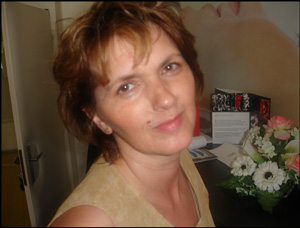
Declaration:
“This is another
moment to stop and remember the times when the idea of the museum
establishment was born. Every thought is a seed of a deed and that is
why the thought needs to be strengthened by will power, so that it
became a clear idea and finally a deed.
The inner
ambivalence of wanting and, at the same time, not wanting something is
usually a serious obstacle when trying to achieve will power and life
success.
The oft repeated
and world-known phrase of Andy Warhol „I come from nowhere,“ is a reply
to a question about his roots. Slovakia has been linked with the name of
this genius in art for over fifteen years. Thanks to the fame of the
artist, which has not fallen silent even after we have moved to the 21st
century, the world is also starting to be aware of Slovakia. This can be
assumed from the attendance of tourists and admirers from various parts
of the world. After all, it concerns an artist, the roots of who are
definitely in Slovakia, and what is important, he opened a new point of
view of the world as well as the way of understanding our, then, 20th
century.
Well, who would not
like to be respected by those, whom he is in touch with? We all desire
for our true value to be fully appreciated. We need to feel we are
important in our small world. We do not want cheap compliments,
insincere sweet talk, but we long for genuine appreciation. The lives of
many people would probably have run quite different courses if someone
showed them their importance.
The Museum of
Modern Art in Medzilaborce deals with the roots, life and work of Andy
Warhol, as they appear in the light of documented facts and not some
conjecture. A visitor or an art critic can, of course, have various
requirements. It depends what his taste tells him.
The museum
continues in its acquisition work and even extends it to the forms of
gifts and purchases. My genuine thanks go to the leadership of U.S.
Steel Košice for their sponsorship gift of the portfolio ”Ladies and
Gentlemen“; to the former Prime Minister of Slovakia Mikuláš Dzurinda
for providing the grant from the Government Office of the Slovak
Republic in Bratislava for purchasing A. Warhol´s work „Kimiko“; to the
ambassadors of the Slovak Ministry of Foreign Affairs for the financial
donation, thanks to which the purchase of the trilogy ” As I Opened
Fire” by Roy Lichtenstein could be realised; to Mirko Kaliňák, the Mayor
and a member of the Town Council of Medzilaborce for the financial
contribution for the purposes of Andy Warhol´s original work ”Electric
Chair “ and to Dr. Peter Chudík, the head of the Prešov Self-Governing
District and a member of the Representative Group of the Prešov
Self-Governing District for purchasing the precious portfolio of A.
Warhol´s works „Flowers (Black and White)“.
It needs to be said that
a lot has been written about Warhol and also about his many friends and
relatives – the well-known ones, those half-forgotten and even those
completely unknown. I am sure that many others will write about him as
time goes by and it looks as if Andy was walking alive by our side.
Every publication will probably be different from the previous ones. It
is delightful that everybody can take a pen and blank paper and, as a
sign of respect, try to write their own declaration.“
Michal BYCKO
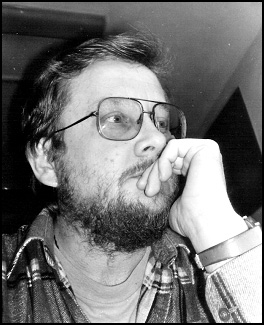
PaedDr. Michal BYCKO,
PhD., F.A.B.I.
the Deputy-Director of
the museum, the main curator, museum-educologist, an art theoretician
and critic, the author of six monographs, dozens of academic articles on
contemporary art, museum and gallery activities and museum-educology
(focused on perception, suggestion and manipulation in art). A member of
the American Biographical Institute in the USA (F.A.B.I.).
Declaration:
„If you want something not to work, set up a committee!“
”That is what it also looked like when the
idea of founding the Andy Warhol Museum in Slovakia (!) was being
realised. An amazing fact in our world is that the most intelligent
creature – man – is so flexible and adaptable ...that what he spat on
yesterday; today he is ready to pin on his chest as a badge.
Andy, discredited before 1989, today has
become the tool of ”boast“ of primary, secondary and tertiary clerks,
who, until the ”Velvet” revolution, did not have a good word to say
about him. History is a very shaky witness to the status quo of the time
and the ”stronger dog is always right...“. But we have not gone stupid,
speechless or blind and, thanks to God, we are alive and can witness the
truth, which is – if there was not for the absolute truth, which is
unachievable for us – now plain to see. The question is, and I would say
that´s what it depends on; how many of us who know the truth about the
whole ”Golgotha-like” foundation of the Andy Warhol Museum of Modern
Art (AWMMA) in Medzilaborce, who witnessed the days in the mist of the
lies and the Satanic offers in the future„ ... will close like a rotten
door“ and deny themselves. Because, in the words of my late father: ”If
you want to see a real beast, give a human indefinite power!“. I am not
sure whether the mirror of the truth, which will be interpreted by
someone, will not be a ”curved mirror “shoed by the force of the power
of the ”real beast “.
I am glad that today,
the risky truth was taken by a young and unburdened man, who has worked
hard and de facto and de jure built the truth about the establishment of
the AWMMA and its work, bravely facing us and himself. That he wrote the
real truth is most important. Even though “cheerleaders“ of delusions of
grandeur will continue in brainwashing lax brains of the supporters and
consumers of tabloids, that they are ”God’s soldiers“, they will give
”birth“ to new names, which they will paint with “fame“ and ”credit“ for
nothing.
Štefan MAŽERIK, I would like to thank you
also on behalf of John Warhol, Vlado Protivňák, Alexander Zozuľak,
Michal Turok, Vladislav Grešlík and the whole small group of people, who
have either with or without fear stood by our side and supported our
idea to establish the museum. It is not easy for me to write words which
smack of boasting. But let it be! Important is that you have written the
TRUTH. It is also your notional ”15 minutes of fame “.
Similarly, I would like to thank Mrs Iveta
RUSINKOVA for her tireless work in documenting the years of “15minutes
of fame“ so exhaustively like nobody had ever done. The notional “15
minutes of fame“ is hers, too.
Let me thank all my contemporary and former
colleagues, who worked in AWMMA either for a short or a longer period of
time. I consider the presence of each of them a tile in a mosaic of our
Institution´s ”existence “.
And
thus, Our Father, Andy, John, Paul, Fred, Archibald, Joel, Evelin,
Pamela, Tim, Vincent, Billy, Riva, Mark, Jeffrey, Danny, James, Jiří,
„Agnes“, Saša, Michal, Ivan, Eugen, Vlado, Dano..., but also you, dad
and mum, and my family ... THANK YOU! If it was not for your will,
willingness and support, there would not be 15 years of the museum. I
SINCERELY WISH IT TO KEEP BEING STRONG AGAINST DILETTANTES AND NICE TO
THOSE WHO KNOW THAT TO BE A TRUE MAN MEANS TO HAVE SPIRITUAL VALUES AND
DIMENSION!“
Alexander ZOZUĽÁK
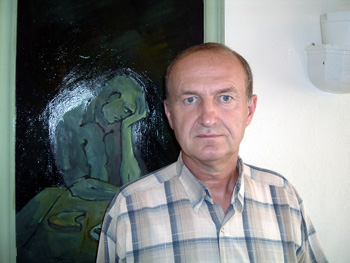
They
have ”enticed” the world to Medzilaborce
The Vice-President of
the Andy Warhol Association, an establishing member of AWMMA in
Medzilaborce and the Rusyn Revival. He works as a journalist and
editor-in-chief of Rusyn periodicals and non-periodicals. One of the
most significant personalities of the Rusyn Revival in Slovakia
after1989, the Deputy of the World Council of Rusyns who is the chair of
other Rusyn organisations and institutions. A working artist.
Declaration:
„Who? Especially three
people: Andy Warhol, John Warhol and Michal Bycko. It is mainly they to
who appropriate gratitude goes today. Thanks to them, Medzilaborce has
become world-famous and today, after 15 years of the AWMMA’s existence,
many art fans and tourists from abroad know about it. They would never
look for such a town as Medzilaborce on the map, they would never visit
it, they would never know that there are some Rusyns and that the most
famous Rusyn in the world is no one else but Andy Warhol, whose parents
were Rusyns and came from a nearby Rusyn village on North-East of
Slovakia – Mikova. Warm thanks to you three for that!
That a museum with Andy
Warhol’s works and artefacts in Medzilaborce was the first to be
established, is a fact not appropriately respected and appreciated by
many Rusyns from the homeland and abroad as well as other inhabitants of
Slovakia, which is sad. Good evidence of this is the museum’s Visitor’s
Book, which shows that the stand of modern art of the world-famous
representative of pop-art is more often visited by foreigners than
local people, which is sorrowful, but it also confirms the following
saying: “You will never be a prophet at home!“ Unfortunately. However, I
believe that the young generation will at least partly correct the
saying by an increased interest in the unique museum of Medzilaborce and
the personality of Andy Warhol as well as the effort and work of Michal
Bycko, the establisher of the museum and the Andy Warhol Association.
Speaking of the
foundation of the Andy Warhol Association and the idea of establishing a
museum of Andy Warhol’s art nowhere else but in Medzilaborce; on this
festive occasion of the 15th anniversary of the AWMMA, I must
also ”blow my own trumpet“. But not in the way many people unworthily do
nowadays, but truthfully and accurately. I have to admit that I was also
present at John Warhol’s (Andy Warhol’s brother) first visit to
Medzilaborce and his parents’ birthplace in Mikova. His dream came true
also on behalf of his already late brother. It happened at the visit of
Vladimír Protivňák’s relatives, where, together with him, it was also
the two of us visiting – Michal Bycko and myself. On the same occasion,
such an idea was born as to, with the help of John Warhol and the Andy
Warhol Foundation in the USA, establish the museum nowhere else but in
the Rusyn centre, which is the town of Medzilaborce; and not in such big
cities as, in the times of Czechoslovakia, Bratislava or Prague were.
Michal Bycko not only suggested the idea to John Warhol, but also, with
the help of several supporters, realised! (Then, I could take part not
only as an art enthusiast, but also as a journalist and interview John
Warhol for the first time, as well as to pass the news about the unique
intention to establish an Andy Warhol Museum in Medzilaborce to, at
least, the Rusyn “world”.) And it has always been M. Bycko, who is the
heart of the museum. And that is why, on my behalf and behalf of the
Rusyn organisations and institutions that I represent, such as the World
Congress of Rusyns, the Academy of Rusyn Culture in the Slovak Republic,
the Slovak Association of the Rusyn Organisations and Rusyn and Ľudové
Noviny Press; I would like to say the following: “Вдяка Ті, брате-Русине,
лем вытрим дале в зачатій і зреалізованій роботї, бо без сердця умерать
тїло, а то все є велика страта. Дякую Ті, же єсь „притягнув“ світ до
русиньскых Міджілаборець.“ (Thank you, brother Rusyns, keep doing the
work you have been doing, because the body would die without the heart,
and that would be a great loss. Thank you for bringing light to the
Rusyn Medzilaborce.)
Michal ŠMAJDA
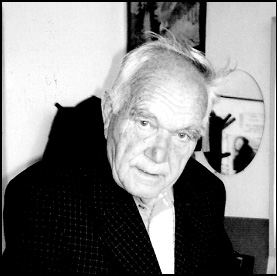
Warhol and Medzilaborce
– “the land of dreams and the reality “
A novelist, folklorist
and an ethnographer. He published dozens of monographs (novels, short
stories, academic studies...). The establisher of the Museum of Rusyn-Ukrainian
Culture in Krásny Brod (when established, it was called the Museum of
Ukrainian Culture).
He lives and works in
Krásny Brod near Medzilaborce.
Declaration:
In the history and
presence of every land, ethnic group and nationality, there are
personalities who form the “mark“ of its spiritual quality. The Rusyns
are a dying-out nation, which has, for the centuries, lived in the
regions of Slovakia, Poland, Ukraine, Romania… where the Rusyn, Lemko,
Boyko and Hocul ethnic groups are living nowadays. Andy Warhol was the
fruit of love of two modest and poor
people - Andrej Varchol and Júlia (Ula) Zavacka. He was born far away
from his parents’ fatherland, but his parents presented him with a piece
of the fatherland in form of genes, upbringing, belief and traditions;
so that it stayed in him for his all productive life. A simple boy of
Rusyn parents from a peripheral part of Pittsburgh, achieved the Olympus
of Fame in art and forever obtained a brightly twinkling star in the sky
of the fame.
Dr. Michal Bycko
said that Pittsburgh to New York is like Medzilaborce to Prague. It is
said that everything repeats this. Andy who came from Pittsburgh,
conquered fame in New York, the Mecca of art, so that he could come
back, for the eternal peace, to the Rusyn cemetery in Pittsburgh. As a
tribute, the town has founded a museum (The Andy Warhol Museum).
However, even before then, thanks to John Warhol and Michal Bycko, Andy
could symbolically return to his parents’ birthplace, when the AWMMA in
Medzilaborce was established. Many of us know the almost thorny journey
of the museum’s founding, but no one competent has overcome himself and
thought of openly declaring the credit of these two men (John and Michal).
Simply, nobody has thanked them in public. Apart from Prof. Stadtrucker,
who, 15 years ago in the Weekly Magazine of Literature, expressed his
gratitude. Since, as if we all have gone deaf, blind, as if we have
forgotten. Well, let me, an old man who has dedicated all his life to
culture and art, express my gratitude.
THANK YOU, MR JOHN
WARHOL, AND ALSO YOU, MICHAL BYCKO, FOR THE IMPOSSIBLE THING YOU HAVE
DONE FOR THE FAME OF OUR ETHNIC GROUP AND OUR STATE IN FORM OF THE
LOVELY MUSEUM OF ANDY WARHOL IN MEDZILABORCE.
I am
keeping my fingers crossed for you, my dear friends, the employees of
the museum, and wishing lots of health, strength and success. If it was
not for your museum, this part of the world would be forgotten. It would
stay only “ .. in the shade of the forgotten ancestors“.

Warholovce
In
Medzilaborce, the pavements, car parks and the amphitheatre are being
repaired because of the „painter Andrijko“; but still, the museum’s roof
is letting in water.
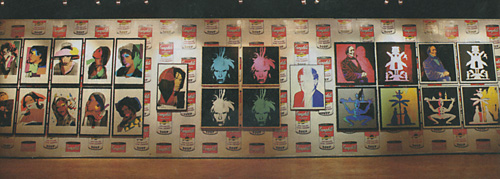
If
it had not been for Warhol, there would be no museum, and if there was
no museum, Medzilaborce would probably be just a nondescript town on the
map of North-East Slovakia. Not even the money for its promotion would
find its way there. The town is still out-of-sight, out-of-mind; but it
has an extraordinary museum. It was opened fifteen years ago with great
pride, and since, it has found its way into the world. Only the
provincial town, the regional capital neighbouring the birth place of
the king of pop-art’s parents has not been successful. As if the museum
and the town lived different lives. Medzilaborce, thanks to Andrijko,
whose fellow-citizens speak Rusyn, has recently obtained further
millions from the European foundation. They will be used in a “special”
way – without creativity and originality. They will not make the town an
open gallery of arts to promote it, they will rather repair what needs
to be done – the pavements, a run-down amphitheatre and the car parks.
And, moreover, a Warhol village will be built – some kind of mini
open-air museum, of which the only connection with Warhol will probably
be its name. A rather large outlay for a small return.
Mausoleum: „The museum is located at the right place, but still, not in
the right time,“ says Michal Bycko, the curator of the museum and a
museo-educologist, as his calling card says under a black-and-white
portrait of the Rusyn superstar. It was he who set in motion the issue
of the town of six and a half thousand inhabitants located at the
North-East end of Slovakia and in 1991, together with other enthusiasts
founded the Andy Warhol Museum of Modern Art. For some, until today, an
incomprehensible enterprise of several fools. Michal Bycko has made his
American dream reality – to have, in Slovakia, a memorial to the roots
of an artist whose parents moved from nearby Mikova to America. The New
York Andy Warhol Foundation presented several valuable works. At the
beginning, there was nowhere to hang them, there was no interest. After
the fall of communism, during which Warhol was considered an unworthy
artist, everybody started to adopt him as a cause celèbre. The
Poles, the Slovenians, the Czechs and the Hungarians. The truth is that
Medzilaborce blindly stumbled upon Warhol. If it had not been for the
socialist planners, who ordered the building of a megalo-maniacal
cultural house opposite the Orthodox church, the original works would
have ended up somewhere entirely different. In Medzilaborce, a building
and six million Slovak crowns for its reconstruction have been set aside
for the museum. The money has somehow disappeared and so the following
decision has been made: the works will be hung in the cultural house,
which has not even passed an initial inspection. Despite the protests
of the locals, the enormous building resembling a mausoleum has become
Andy Warhol’s citadel. The complicated soundproofing system, which was
supposed to separate a wedding party in the restaurant from a film
screening, has been ripped out, bare walls have appeared and spectacular
rooms have been created, into which, immediately after its opening,
water began to seep. And it still seeps today. The museum can be found
in every tourist guide to Slovakia. However, this is not enough to
attract tourists to come to this area. Unfortunately.
Warhol City: At the municipal office Warhol is presented almost as a
saviour. Not even Pittsburgh where he was born is so enamoured by him as
Medzilaborce. The projects carrying his name are supposed to promote the
town. At least that is what it says on paper. “Although Warhol is not a
remedy for unemployment, many working positions are connected to him,”
says Vladislav Višňovský, the director of the first-contact centre. He
also adds that “Medzilaborce, on its own, is a dump”. And that is how
the prodigal son, with the help of the European Union Foundation,
returns to his parents’ fatherland. He, while he was alive, never came
to Slovakia. The first stage of the Warhol City project cost two and a
half million crowns for “imaging” alone. For this money, three bus
stations and six pop-art style facades were “Warholised”. The town came
to life in places. However, Dr Bycko as the author of the artistic
proposal is not happy with the realisation. According to him, it is of
poor quality. “The platforms were supposed to give out light. I proposed
newsstands and a campsite in the shape of Warhol’s iconic Campbell’s
soup tins. None of this was realised,” he laments. Several facades are
not enough. The whole town should flourish with Warhol; however, it does
not have enough chance.
The
Warhol Open Air Museum: Andy has also become the focus of the second,
more difficult part of the project, for which the town has obtained
thirty million crowns. However, it does not only involve the European
foundation. One and a half million had to be approved by the town
council from the Medzilaborce budget. The state gave a sum of six
million. This is what the rules are. “It is one of a few
well-thought-through projects. A ski lift can be anywhere; Warhol
cannot,“ declares engineer Višňovský. The second stage is rather more
building-oriented. The pavements, car parks will be repaired, the
amphitheatre will be reconstructed and an open-air museum named Warhol
Village will be built. “It will contain mini replicas of architecture
typical for this region, including the church in Mikova,“ we learn at
the municipal office. „What does it have to do with Warhol?“ asks Michal
Bycko expressing his dislike of the miniature village. The clerks have
their own secret agenda. He, allegedly, usurps a patent on Warhol. It is
true that, for a long time, their ideas on promoting the town have
differed. Is it mutual silence or trench warfare? It is hard to say. At
the office, they are already planning the third phase of the project.
Maybe, they will also deal with the repairs of the saturated museum. It
seems that the town representatives have a clear idea. “We want
Medzilaborce to symbolise Andy and become attractive to tourists,“ says
project coordinator Adrián Kaliňák. The local Romany community are also
actively involved. They have already stolen the underground cables from
the open-air museum that is being prepared.
What
do we need Warhol for? How do the local inhabitants perceive Warhol? As
a world-famous artist, a fool, lunatic, weirdo? “None of the above. They
use him to boast in spas when they mention they come from Medzilaborce,“
Curator Bycko says with conviction. “What good is Warhol, when we do not
have work?” was the legitimate question posed by Miro Hudák, a local
man. He is right in his own way. He does not care much for Warhol, but
he has visited the museum where the entrance fee is a hundred crowns.
The first and last time, similarly to most tourists who were drawn there
by the work of the king of pop art. Yearly, fourteen to seventeen
thousand visitors view his work, two thirds of whom come from abroad.
And there is something to admire. Apart from other things, over a
hundred original works. Their value has been estimated at tens, maybe
even, hundreds of millions of crowns. “It is a window through which we
can view Warhol’s creative body of work. A little sample of everything,“
declares the leadership of the museum. “Nobody for miles around has gone
into Warhol‘s whole life and work as much as I have,” says Michal Bycko
antipathetically. He is 54 and Andy has become his fate. Because of him
he got “stuck” in Medzilaborce and he hardly ever leaves. “I am crazy
about him and now it’s driving me mad,” he admits, with one condition:
He does not want his picture taken with Warhol or his works. The
situation of Andy’s double, Endi from nearby Rokytovce, is diametrically
opposed.
Doppelganger Endi: Since František Lakata, an Art teacher at a Primary
School in Medzilaborce, played Andy’s role in the film called Absolute
Warhol, the whole village has called him Endi. When he puts his make-up,
wig and glasses on, it is like Andy staring back at you. It was none
other than Michal Bycko who discovered him. Allegedly, he looked at him
and saw Andy. Suddenly, the museum had a mascot and Endi became famous.
Since then, he has not missed any exhibition opening, he “does” Warhol.
Just next to the local gym in Rokytovce, he made a local gallery from a
former school. It was named after his local nickname - Endi. He exhibits
his paintings, sculptures, woodcraft – his art. He admires Andy. “He was
not a Slovak, he was a Rusyn, and, moreover, more famous than Vasil
Biľak.“ Allegedly, Endi even has a similar voice to Andy’s. “His brother
John told me,“ he clarifies. At a school, he set up a board as a tribute
to his double. Apart from other things, painted-on women’s high-heel
shoes are hanging on it. He makes them with children. Just like Warhol,
when he started to conquer the world.
Unlucky Miková: While the news about Warhol City is also released by
foreign press agencies and mass media; the dying-out village of Miková,
located 13 kilometres from Medzilaborce, stays in the shadows. The
birthplace of Andy’s parents. “They have stolen Andrijko from us,“
complain the local inhabitants, addressing the Medzilaborcians. „We have
no memorial to Andy in our village,“ Mayor Alexander Vaco guesses
everything is over. However, Miková has already had big plans, too. A
memorial house and a car park for six buses. Nothing of this worked out.
To commemorate Warhol, they named the festival of Rusyn culture after
him. Only a well and a pear tree, which has recently been pruned by
electricians, are left of his parents’ legacy. The original house with a
straw roof has long since disappeared. However, crowds of curious people
come. Now and then, they visit Ján Závacky, Andy Warhol’s cousin, a
former mayor. “I knew I had a painter cousin in America. I thought he
painted houses. Just later, an artist hatched out of him. If the world
recognises him, I am proud that his roots go back to Mikova.“ It upsets
him that, despite the villages’ best efforts, there is nothing left of
Warhol. Maybe just plenty of namesakes, most of them in the cemetery.
And their names are spelled differently. Varchola, not Warhol! “I come
from nowhere,“ that was his stock-in-phrase sentence. He would hide his
roots, but they are mirrored in his work.
Prophet of consumption: Warhol’s artistic propositions
rather belong to marketing strategy and in this way, he was unbeatable
in his era. He knew how to sell his work, he was “walking art” himself.
He would surely make Medzilaborce unrecognisable. What it needs is an
idea. „Andy, looking at the town, must turn in his grave,“ this is how
the eccentric curator sees it. And not because he is buried in
Pittsburgh next to a John Slota (Translator’s note: There is a
Slovak politician with the same name fighting against national
minorities.). „To be always present yet stay in the background,“
this was Warhol’s motto. In the case of Medzilaborce, the town council
live by it to the fullest, they do not even know how much. Although Warhol is still in the town, on first inspection it seems he is not. Who
knows for how long.
Juraj Sedlák
14.07.2006

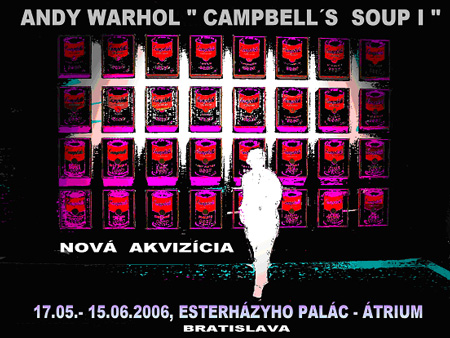
Warhol is
better known in Serbia than in our country
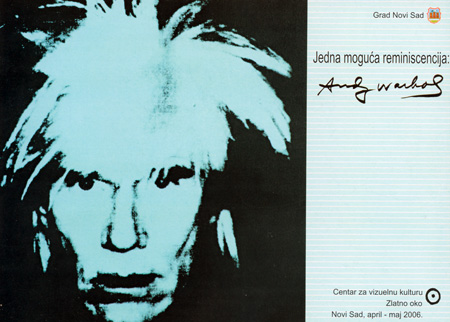
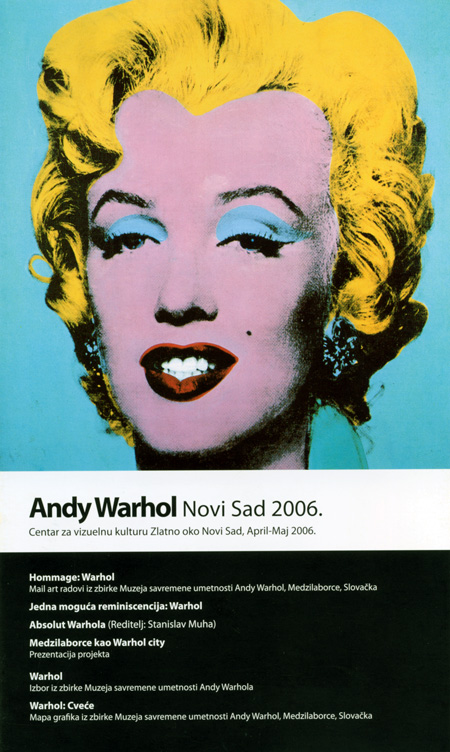
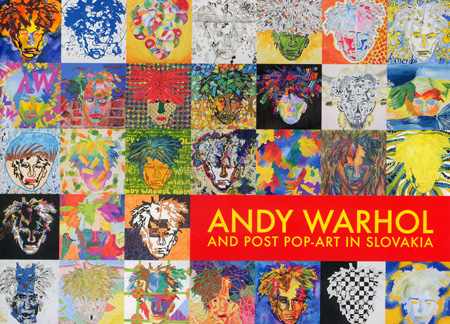
One main
representative catalogue-publication (82 pages of the text, more than
200 black and white and colour reproductions) and three small
catalogues, dimensional placards along the road in the distance of 30
kilometres close to Nový Sad, miniature promotional items, great
interest from part of media... – all of the abovementioned was the
natural part of the project ANDY WARHOL – POST
POP-ART IN SLOVAKIA in the Serbian town of Nový Sad.
The project
consisted of more parts – the individual events, exhibitions mainly. The
first exhibition, and that is the mail-art international exhibition
Homage Andy Warhol out of the collection of the Museum of Modern Art
of Andy Warhol (MMUAW) in Medzilaborce and Voyvodina Slovak, Mr.
Jaroslav Supek, was opened on 25th April 2006 at 06.00 p.m. in Bel
Art Gallery. The second exhibition – Slovak and Serbian pop-art
was opened at the same evening at 07.00 p.m. in Voyvodina Museum.
The third exhibition under the title Flowers Black and White
(series of 10 black and white A. Warhol paintings) was opened at that
evening at 08.00 p.m. in Centre of visual culture. At the same time
in the cinema Bioskop of Cultural Centre of the town the presentation of
documentary film of known Polish director Stanislaw Mucha – Absolut of
Warhol took place. On the second day, on 26th April 2006 in
Municipal Information Centre the presentation of the project of
Municipal Administration Authority in Medzilaborce – Warhol City took
place and was introduced by Mr. Vladimír Protivňák, the officer of the
Municipal Administration Authority. The forth and main exhibition had
its opening in the Gallery of Voyvodina Bank in Novy Sad at 08.00 p.m.
under the title WARHOL and thousands of spectators were coming to
see it until 01.00 a.m.!!!
More than
300 exhibits formed the most large-scale exhibition of Andy Warhol works
in Serbia. Organisers in Novy Sad invested the millions into the
project. Thousands of people in long line were coming to the exhibitions
in Novy Sad as they used to be queuing in front of the Lenin Mausoleum
in Moscow. They came to see the exhibited art works and artefacts about
the work, life, and Rusyn origin of Andy Warhol. About 100
original works, more than 50 artefacts, documents, the art works of
Slovak and Serbian post pop-artists and known world mail-artists formed
the content of “festival” dedicated to the greatest Rusyn of 20th
century in the world – Andy Warhol, which shall last until 20th
May 2006. Not only the project organisers (the Municipality of
Nový Sad under the patronage of the Minister of Culture of Voyvodina and
the Andy Warhol Museum of Modern Art in Medzilaborce) and
authors - curators (Dr. Michal Bycko, PhD. and Mgr. Martin Cubjak
from Slovakia, Jaroslav Supek, M.A. and Dr. Sava Stepanov from Serbia),
but also the media and alike were almost shocked because of the great
interest. Three days after the exhibition opening the fax asking for the
re-implementation of the project in Belgrade was delivered to the Andy
Warhol Museum of Modern Art!
This is the
present condition Warhol enjoys in Serbia. Wish we get our acts together
as well and start realising what we have at home and decide to present
things the world is interested in. Hardly anybody would take interest in
neverending folklore performances and gnocchi with sheep cheese. We live
in the third millennium!
Dr.
Michal Bycko, PhD.
one of the
project authors

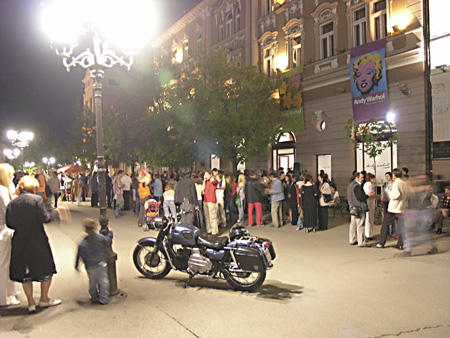
This is what it looked like in front of
the Voyvodina Bank Gallery in late evening hours on 26th
April 2006, where the main exhibition – WARHOL was installed.
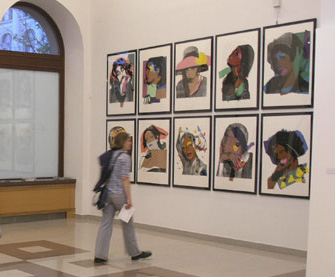
Exhibition premises of the Voyvodina Bank
Gallery, displaying on its front wall the
series of 10 works of A. Warhol under the
title Ladies and Gentlemans.
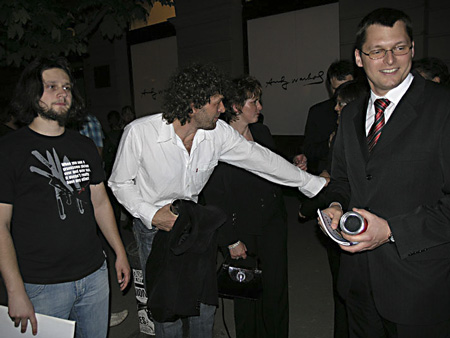
From the
opening of the main exhibition Warhol:
(from left
to right) The opening exhibition curator Mgr.
Martin Cubjak, Minister of Culture of Voyvodina Radovan Jokič, the
Directress of the Andy Warhol Modern Art Museum in Medzilaborce Mgr.
Valika Maďarová and 3rd secretary of the Embassy of the
Slovak Republic in Serbia Tomáš Ferko from Belgrade.
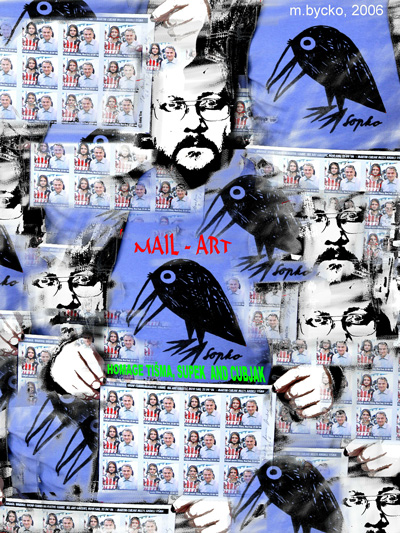
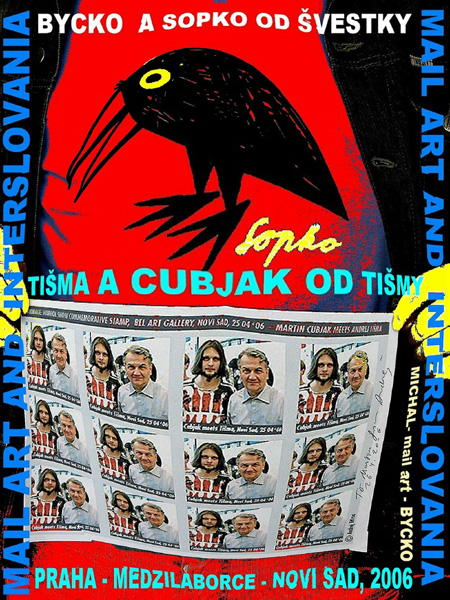
Mail-art work by Michala Bycka as a
response to the project Andy Warhol – post
pop-art in Slovakia.

THE
GALLERY OF SOME
OF THE PAINTINGS
WORLD-FAMOUS RUSYN,
ANDY
WARHOL
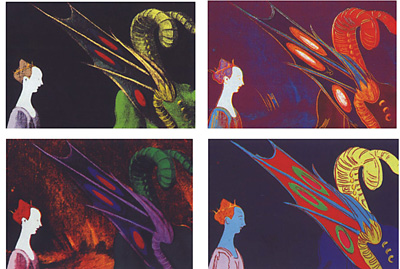
Details of Renaissance Paintings; (Paolo
Uccello, St. George and The Dragon, 1460)
Medium
Screenprint on Arches Aquarelle (Cold Pressed) paper.
Year
1984 Size 32" x 44", image 25" x 37"
Edition
of 50, 12 AP, 5 PP, 4 HC, signed and numbered in pencil lower left.
There are 36 TP portfolios , signed and numbered in pencil lower left,
containing print II.316A and one image from each of Details
portfolios(II.316-319, II.320-323, II.324-327).
Misc.
Portfolio of four screenprints.
Printer: Rupert Jasen Smith, New York
Publisher: Editions Schellmann & Klüser, Munich, Germany / New York
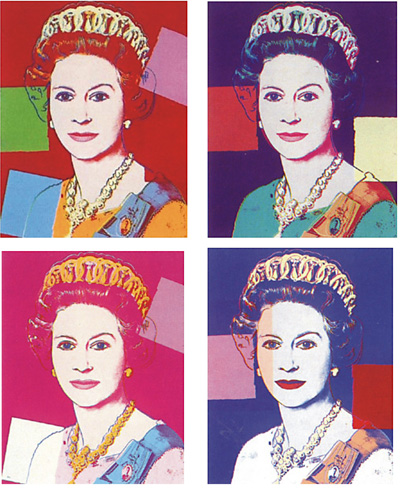
Reigning Queens: Queen Elizabeth II Of
The United Kingdom
Medium
Screenprint on Lenox Museum Board.
Year
1984
Size
39.375" x 31.5"
Edition of 40, 10 AP, 5 PP, 3HC, 30 TP containing only one image
of each queen, signed and numbered in pencil lower right
Misc.
Portfolio of sixteen screenprints.
Printer: Rupert Jasen Smith, New York
Publisher: Geaorge C. P. Mulder, Amsterdam, The Netherlands
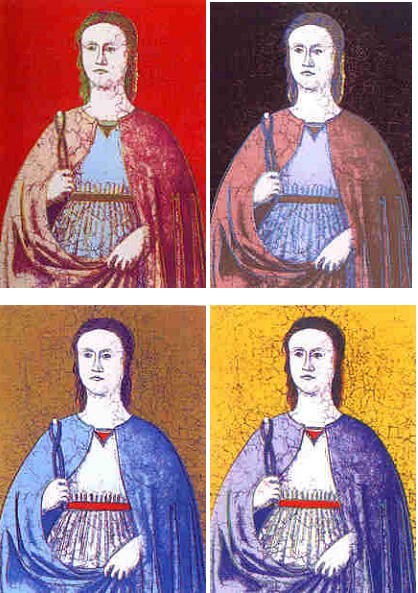
Title Saint
Apollonia ( F/Sch: 330 – 333 )
Medium Screenprint on Essex Offset Kid Finish
paper.
Year 1984
Size 30" x 22",
76,2 x 55.9 cm
Edition of 250, 35 AP, 8 PP, 80 individual TP
not in portfolios, 20 individual TP not in portfolios numbered in Roman
numerals, signed and numbered in pencil lower left. The prints TP
1/80-29/80 are on Arches 88 paper with the image reversed, 43" x 30.5";
TP 30/80-80/80 and TP I/XX-XX/XX are on Essex Offset Kid Finish paper,
35" x 23"; image 30" x 22".
Misc.
Printer: Rupert Jasen Smith, New York
Publisher: Dr. Frank Braun, Düsseldorf,
Germany
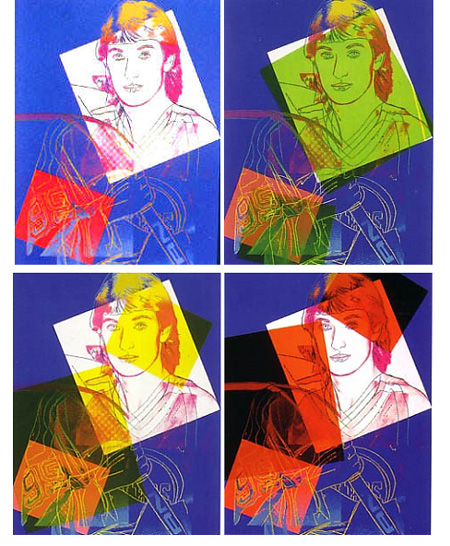
Artist
Andy Warhol
Title
Wayne Gretzky #99
Medium
Screenprint on Lenox Museum Board.
Year
1984
Size
40" x 32"
Edition
There are 46 TP signed and
numbered in pencil on verso by the executor of The Estate of Andy Warhol
on a stamped certificate of authenticity. There are 6 PP, which are
trial proof variations, signed and numbered in pencil lower left. Each
print is unique.
Unique
prints
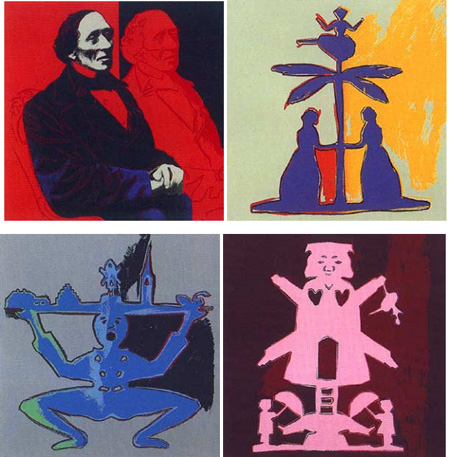
Artist Andy Warhol
Title Hans
Christian Andersen ( F/Sch II: 394 -397 )
Medium Screenprint on Lenox Museum Board.
Year 1987
Size 38" x 38",
96,5 x 96,5 cm
Edition of 25, 8 AP, 3 PP, 5 HC, numbered in
pencil and signed in pencil on verso by the executor of The Estate of
Andy Warhol, the publisher, and the printer on a stamped certificate of
authenticity. There are 36 TP signed and numbered in pencil as noted
above.
Misc.
Printer: Rupert Jasen Smith, New York
Publisher: Art Expo Danmark, Odense, Denmark
 |
